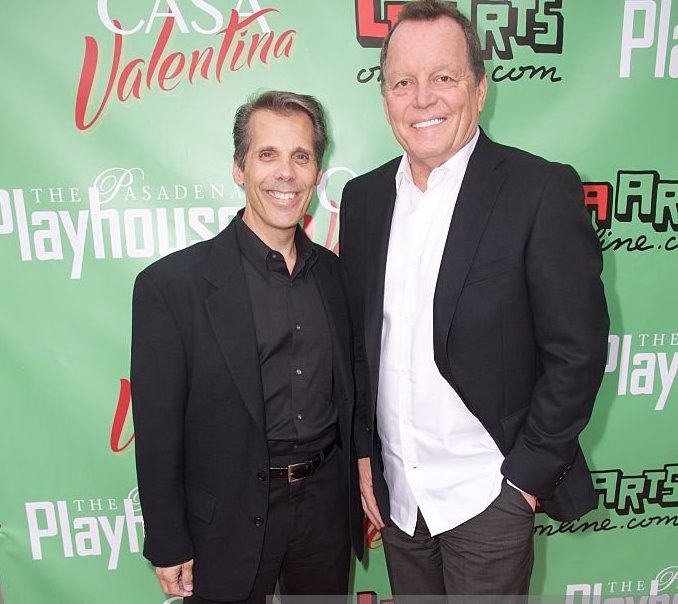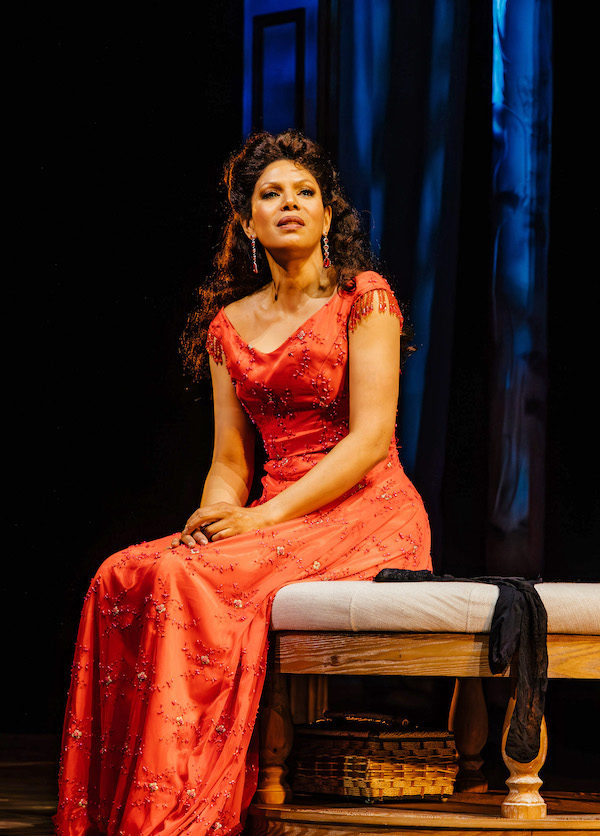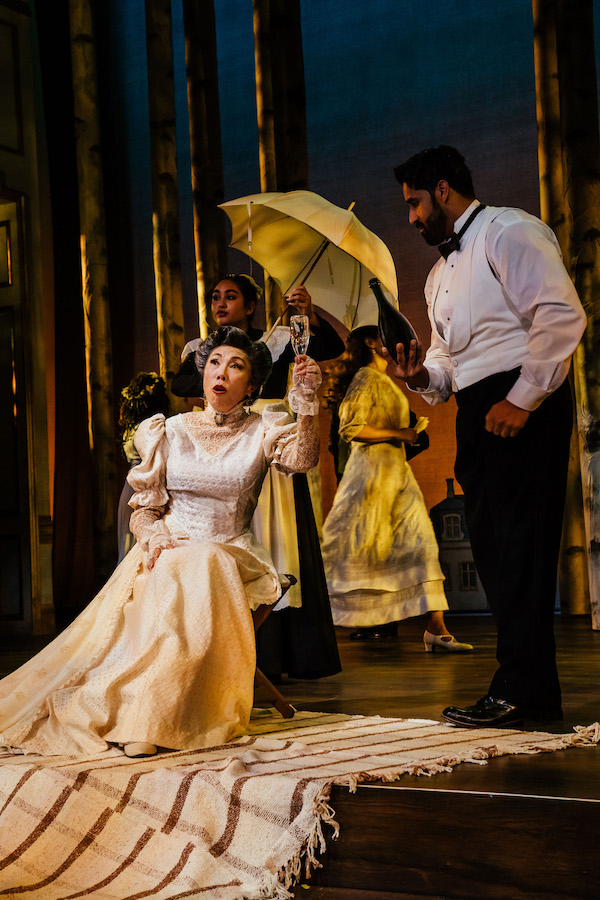A clutch of couples trade partners on a long Scandinavian summer night, some finding their true loves. The Ingmar Bergman film first told the story with flirtatious humor tinged with Swedish melancholy. The Woody Allen film added New York angst to the mix. Leave it to composer/lyricist Stephen Sondheim and his collaborators to take things to another level, telling the tale in waltz time including that composer’s most recognized song “Send in the Clowns.” The original 1973 Broadway production with director Harold Prince won Tony Awards for Sondheim’s score, for Hugh Wheeler’s book, and Best Musical.
A lavish new production of A Little Night Music, complete with the full-orchestration played live by a 22-piece orchestra, is up next as Pasadena Playhouse continues its celebration of Stephen Sondheim.
Together again
For this significant piece in its Sondheim festivities, Pasadena Playhouse artistic director Danny Feldman brought in veteran director David Lee who in turn called on choreographer Mark Esposito. The pair previously teamed on the venue’s award-winning productions of Ragtime, Camelot, and Casa Valentina, as well as South Pacific at the Hollywood Bowl with Reba McEntire.

As rehearsals entered their final weeks, Esposito took time for a telephone interview about working once again with this director, how he used dancing to open the show, and how they tackled unique challenges presented by the distinctive space in this theater.
Despite a career that has include choreographing for theaters across the country and performing in more than 16 national and touring productions, Esposito was quick to point out, “This is my first time with A Little Night Music, but the music is Stephen Sondheim, Hugh Wheeler’s book is brilliant, and the show is so well constructed. When David called I wanted to explore what this show can be in this theater.”
Staging in an historic venue
Esposito described his choreography in this production as “about 25% dance and 75% musical staging,” what he described as “transitions that need to flow to keep the story telling moving forward.”
Before Esposito presented steps to get the actors dancing, the first choreography occurred months before the rehearsals, with the choreographer, director and set designer working with the distinctive structure of the theater for the scenic shifts as well as situating the orchestra and a wheelchair.
Esposito described how setting choreography on any stage involves collaboration with the director and a variety of space considerations whether at the Hollywood Bowl with its wide stage and an onstage orchestra, a converted vaudeville theater or movie house, or in the case of the historic Pasadena Playhouse, the constraints of a theater that evolved from a 1917 burlesque house built with minimal backstage and wing space. Although it has been remodeled over the years, the original architecture only allowed for limited expansion of the backstage and wing space.
In shows like A Little Night Music which move from scene to scene without a curtain, movement of sets, props and people calls for choreography to keep the action flowing. “Sometimes it does feel like we’re playing tetras,” Esposito said.
“One of the first challenges with A Little Night Music was where do we put the orchestra?” Esposito explained, “The burlesque house naturally put the orchestra in front of the stage in front of the seats which pushes the audience seating farther away. David and I wanted to bring the audience closer to the action. We figured out how to move the sizable orchestra behind the actors, still leave room for the play’s action, and bring the audience five feet closer to the stage.”
Another tricky bit of maneuvering involved the character Madame Armfeldt who is in a wheelchair. “With the limited wing space, the movement of set pieces had to be choreographed to allow the actress in the wheelchair to exit into the wings without colliding with the stage crew moving a bed onto the stage for the next scene, but also to get the bed out there for the start of the scene. We worked with the set designer on that and other staging for months in advance. That part of my choreography won’t ever be seen by the audience, if everything moves as it should,” he chuckled.

And then they waltzed
Although this show does not have a traditional number when the action stops and the dancers take over, Esposito’s choreography does take center stage with the opening. He shared that during the overture, the audience first will see a ballroom, a chandelier that lifts up with the music, and then actors dancing in as if at a masked ball.
At the start of A Little Night Music, the characters have apparent connections and also intersecting connections that are gradually revealed. There’s a lawyer Frederick Egerman (Michael Hayden) with his young, still virgin wife Anne (Kaley Ann Voorhees) and Henrik (Chase Del Rey) the son with his late wife who hormonally pursues the housemaid Petra (Ruby Lewis). A second couple is Anne’s friend Countess Charlotte Malcolm (Sarah Uriarte Berry) who knows her husband Count Carl-Magnus Malcolm (Ryan Silverman) is dallying with a famous actress Desiree Armfeldt (Merle Dandridge) who once had an affair with the lawyer. All are soon gathered, by invitation or gate crashing, for a fateful night at the estate of Desiree’s mother, Madame Armfeldt (Jodi Long) who is raising Desiree’s daughter Frederika (Makara Gamble) since the actress mother is forever on tour.
“With the overture, the various couples enter and dance, establishing their characters and suggesting in subtle ways the fractures to be revealed,” Esposito shared, “And then, the couples begin changing partners, further previewing the passions, jealousies and distrust fueling what’s to come until a moment when the French doors open and Desiree enters, the catalyst for everything.”
The clothes that move the character
Esposito also was brought in to work with the actors on their characters’ distinctive movements and to help the director meld various styles of acting among the cast. “Those tasks definitely were aided by the period costumes from the early 1900’s,” he said.
“While the actors came to rehearsal in jeans and casual shoes, for rehearsal the women are in some of their dresses and shoes which are more restrictive than today’s clothes and requires a different way of moving. The men are in tails to get the sense of how people moved differently a century ago,” Esposito explained.

“My job also was to remind the actors of how movement in that time was very different from today. For the women, how they sit, not crossing their knees, for example. With the men, it is the greater sense of formality in how they present themselves to other men and to women,” Esposito explained.
When it came time to set the dancing, Esposito gave the cast movement to get a sense of who was more and who was less comfortable with dancing. He adapted the opening dance and other movement sequences to allow cast members for whom the waltzing came easily to dance more and to simplify the moves for others. While the cast has its share of triple threat actor/singer/dancers, he noted that some opera trained singers who are integral to show find moving and dancing challenging.
“While it is changing, some opera training emphasizes not moving while singing and focusing all the energy on producing the vocal sounds,” Esposito observed, adding that “once given permission to emote and act beyond just their voice, everything is fine. Not sure it’s my choreography, probably it’s something about Sondheim.”
At the time of the interview, the show was in the final rehearsals. Even before it opened, the theater announced the original run was extended to May 28.
